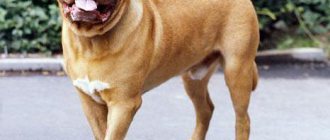- Use of specific (anticoccidiosis) drugs
Coccidiosis in dogs is a common disease caused by protozoa. Such common symptoms as diarrhea in puppies, growth retardation, poor digestibility of food, streaks of blood in the feces, vomiting, high mortality in young animals, alternating diarrhea and constipation in adult dogs, lethargy, apathy - the reasons for which the diagnosis of acute viral infection is made, worms or dysbacteriosis, although very often this pathology is to blame.
About coccidiosis
Coccidiosis is a disease of various species of mammals and birds, caused by protozoan microorganisms, with symptoms very similar to a viral infection, helminthic infestation (worms), poisoning, dysbacteriosis (alternating diarrhea and constipation, poorly digested or insufficiently formed feces) in adult dogs. Causes signs of digestive upset, growth retardation in puppies, poor digestibility of food, metabolic disorders, and decreased immunity. It often occurs simultaneously with other pathologies (helminthic infestation, bacterial and viral infections), aggravating and complicating their course, and can also contribute to their occurrence.
Coccidia are protozoan parasites belonging to the class “sporozoa” (sporozoans). They can parasitize all species of animals, as well as humans, localizing in the cells of the intestinal epithelium, liver and bile ducts and in blood cells.
The causative agent of coccidiosis is quite widespread in industrial animal husbandry, as well as among domestic non-productive animals (according to research, up to 55% of cats and dogs are susceptible to infection), which is due to the following:
- Intracellular parasitism.
- High intensity of reproduction (up to two million parasites from one spore).
- The presence of two methods of reproduction (asexual and sexual), which contributes to genetic variability and the development of resistance (resistance) to the effects of drugs.
- Parasite spores that enter the external environment have a double-circuit shell that protects them from the action of many disinfectants.
In addition to the most common name, you can often find similar ones: “isosporosis” or “eimeriosis”, which is associated with synonymous terms for the names of the pathogen (isospora and eimeria). Since "coccidia" is the name of the order, "eimeriide" is the name of the family, and "eimeria" and "isospora" are the names of the genus.
Due to the fact that coccidiosis in dogs is caused by representatives of the isospora genus (Isospora Canis, I. Ohioensis, I. Neorivolta, I. Burrowsi), the corresponding term is most often used in foreign sources. And the last three types of pathogens are called “ohiensis complex” (due to certain similarities and difficulties in distinguishing).
Preventive measures
Prevention plays an important role! Since coccidia is spread in the external environment through animal feces, it is very important to practice strict sanitation. All (!) feces are collected and burned. They cannot be thrown away, since cysts are very stable in the external environment. The possibility of contamination of water and food with the pathogen should be completely excluded. Clean water is especially important, and the sick animal is provided with plenty of it.
Note that most household disinfectants against coccidia cysts are not very effective. This is why you should use a 10% ammonia solution, boiling, steaming or burning. Remember that cysts can withstand freezing very well, so you shouldn’t rely on “General Frost” either: thoroughly clean and burn the floors of even outdoor enclosures!
Spreading
Isosporosis in dogs, as already mentioned, is a widespread pathology (from 10 to 60% of animals in different regions). Infection occurs when the pathogen enters the mouth of a healthy individual (nutritional).
Sources of infection are:
- Feces of sick animals (especially those with coprophagy, which is often observed in metabolic disorders).
- Contaminated care items (bowls, toys, etc.).
- Water containing pathogen spores.
- Contaminated feed.
- Fur (by licking) and contaminated nipples of nursing bitches (puppies become infected when nursing by their mother).
Puppies are most susceptible from two weeks of age to six months. Adult dogs rarely get sick, most often being carriers. But if certain conditions arise, the carrier state can turn into an active form of the disease, and vice versa - a puppy that is in good condition (fatness, proper feeding, good immunity) may not get sick even if infected.
Coccidia spores are very resistant to many external influences and disinfectants. They die most quickly (in 7–10 seconds) under the influence of high temperatures (from 80 to 100 degrees).
Insects (flies), rodents (mice, rats) and birds can be mechanical carriers of the pathogen.
Prepare before going to the vet
In the office, you may have to provide the veterinarian with all possible assistance (hold the animal while they take blood for analysis, give an injection, extinguish aggression, calm your voice, scratch its ears, stroke it). If you know that you are terrified of blood, IVs, or definitely cannot withstand the type of medical interventions, then perhaps you should ask a friend or relative for help.
Find a veterinary certificate, veterinary passport.
Take:
- Leash;
- Collar;
- Muzzle;
- Carrying;
- A pack of napkins;
- litter;
- Bowl, water (at the veterinarian's discretion)
Prepare answers to possible questions from the veterinarian:
- Are all vaccinations up to date on the animal?
- Pet’s behavior in recent days, appetite;
- His diet;
- What drugs and medicines did you give to the animal;
- Latest test data (if available).
It’s better to make an appointment in advance - you’ll save time and be able to calculate when you’ll have to take time off. This does not apply to life-threatening situations where you will have to take an animal to a veterinary clinic without an appointment.
Be affectionate with your pet, play, talk to him. You can take his favorite toy with you so that while you wait for your turn at the reception, you can distract your friend from the new environment.
https://dog-care.ru/zdorove/bolezni/koktsidioz-simptomy-lechenie.html
Furry, feathered or scaly ones also need to be prepared. No matter how much you want to treat your little one with something tasty, remember: you need an empty stomach. Feeding is prohibited!
You can wash your animal without using detergents. But it is important not to touch your pet if there is nasal discharge, watery eyes, salivation (salivation), dandruff, scratching, rashes, skin scabs, loss of hair/feathers/scales, wounds and other external manifestations of a potential disease.
If the veterinarian has instructed, collect the animal’s urine in a sterile container, and pick up the feces with a stick (no blades of grass, specks, or debris). Transfer the feces into a sterile container. Send to the biochemical laboratory within 6 hours. The feces are examined for eggs of roundworms, pinworms, tapeworms, liver flukes, echinoccus, alvecoccus, pork tapeworm, bovine tapeworm, and gastrointestinal bleeding is detected.
At the veterinary hospital, the animal’s blood will be analyzed for antibodies to allergens, viruses, bacteria, and parasites.
Factors contributing to the development of the disease
In both puppies and adult carrier animals, the development of the disease is facilitated by factors that weaken the immune system:
- Unbalanced (vitamins and minerals, protein overfeeding) or insufficient feeding.
- Sudden change of food.
- Abrupt transition from breastfeeding to independent feeding.
- Stress (change of owners or place of residence, transportation, participation in exhibitions, etc.).
- Hypothermia (drafts, sudden temperature changes, etc.).
- Unsanitary conditions of detention.
- Helminthic infestations.
- Other infectious diseases.
Animals that have recovered from the disease develop stable immunity, but they can remain carriers for life.
The role of stress in the development of pathology is evidenced by the fact that very often the peak incidence in puppies occurs in the first three weeks following the move to a new place of residence (new owners).
Where does my dog get coccidia?
An infected dog passes oocysts (immature coccidia) through its feces. Oocysts are very resistant to a wide range of environmental conditions and can survive on land for some time. At certain temperatures and humidity, oocysts form spores or become infective. If a susceptible dog ingests sporulated oocysts, they will begin to secrete sporozoites, which penetrate the cells of the intestinal mucosa and spread the infection to neighboring cells. Dogs can become infected indirectly from coccidia-infected mice by eating them.
Manifestation of the disease (symptoms)
The interval from the moment of infection to the manifestation of pathology (incubation) can range from three days to two weeks. This depends on the degree of infection and the condition of the infected organism. In children, the disease most often occurs in an acute form, and in adult dogs – in a chronic form. In addition, there are intestinal, hepatic and mixed forms of the pathology.
Symptoms of the acute form of the disease
- Lethargy, depression.
- An increase in temperature may occur, although most often it remains within the normal range, and with the development of pathology it may decrease.
- Diarrhea, feces with mucus and blood.
- Vomit.
- Intestinal bloating (flatulence).
- An increase in the volume of the abdomen (due to an enlargement of the liver and gallstones, as well as due to bloating of the intestines).
- With the development of pathology, exhaustion is observed.
- Dehydration (dehydration) develops.
- The coat becomes dull and disheveled.
- Nervous system disturbances (convulsions and muscle tremors) may occur.
- Anemia of the mucous membranes (pallor) may also develop.
- High probability of death (especially in small puppies).
Manifestations of the chronic form of the course
- Animal fur loses its shine and becomes dull.
- Vomiting may occur periodically.
- Diarrhea may alternate with constipation.
- Progressive exhaustion begins to appear.
- Weakness and apathy appear.
- Dysbacteriosis develops.
- Pathogenic microflora (staphylococci, streptococci, E. coli and others) are actively developing in the intestines, which were previously opportunistic.
- Against the background of a weakened immune system, other pathologies may develop, as well as helminthic infestation.
With a long course of the disease, destruction of the intestinal mucosa occurs, impaired absorption of nutrients, and the development of necrosis. This leads to stunted growth in young animals, decreased immunity, increased intoxication, and complicates treatment (most drugs act in the intestinal lumen without affecting pathogens localized in the intestinal wall). And even after complete recovery, intestinal functions may be impaired for a long time (additional restorative therapy is required), which in general will be important for the entire subsequent life of the puppy. Therefore, with a disease such as isosporosis in dogs, treatment should begin when the first clinical signs of the disease appear (the earlier, the more effective) and special attention should be paid to prevention.
Transmission routes
A puppy is not born with a bunch of coccidia in its intestines. But if the mother is infected, then the pathogen cysts will almost certainly get on her nipples when licked. And from there they have a direct path - into the intestines of puppies. Since young animals do not have any immunity to this pathogen, clinical signs of the disease develop quickly. Cases of death cannot be excluded.
From the pathogen entering the body until the first symptoms appear (most often) about 13 days pass. In puppies and severely weakened animals, the process proceeds much faster. In most cases, young animals become infected from their mother, but there are exceptions. Any sick puppy is dangerous to its brothers and sisters. This is especially important for professional dog breeders, as well as animal shelter staff: if at least one animal in the litter shows symptoms of coccidiosis, it must be immediately isolated from other healthy ones.
Diagnostics
When diagnosing, all data is taken into account (history - information about symptoms provided by the owner, the epizootological situation in the region, the results of a clinical examination and autopsy).
The main diagnostic criterion is the results of stool flotation studies, based on traditional methods (Darling and Fulleborn), as well as using a sugar solution (more effective, improves microscopy results). The final diagnosis is made based on the detection of 10 spores or more in the field of view using standard magnification. Such studies can be carried out by almost any veterinary clinic that has at least a minimal laboratory (centrifuge, reagents, microscope).
However, diarrhea may appear before the spores are detected, therefore, when making a diagnosis, it is imperative to take into account the clinical manifestations and all the above data, and, if necessary, carry out repeated studies (over time, after some time).
Treatment
Treatment of coccidiosis in dogs, like the treatment of any infectious disease, is based on the following principles:
- The use of specific (etiotropic) drugs aimed at eliminating the main cause - the causative agent of the disease.
- Symptomatic therapy, it is aimed at eliminating the consequences of the development of pathology (dehydration, inflammation in various organs and systems, dysbiosis, and so on).
Use of specific (anticoccidiosis) drugs
Any veterinary pharmacy can provide a wide selection of anticoccidiosis drugs. In most cases these are cocidiostatics. Sulfa drugs (“sulfodimethoxine” and others) are often recommended. But when choosing a drug, you need to understand that sulfonamide drugs and some antibiotics (“tetracycline”, “kanamycin” and others) have been used for a long time, therefore the adapting pathogen has been immune to them since the end of the twentieth century.
If we take into account veterinary drugs developed back in the last century, then we can talk about the effectiveness of only “Amprolium” (drugs “coccidiovit” and others).
For greater effectiveness, rotation of coccidiostats and antibiotics is used, but such therapy also has many disadvantages.
Disadvantages of outdated therapy
Let's start with the definition of the term coccidiostatics - like bacteriostatic antibiotics, these are drugs that act on the pathogen (bacteria or protozoa) by disrupting its life cycle. Therefore, during treatment:
- Due to its slow action (compared to coccidiocides or bacteriocides - drugs that kill coccidia and bacteria), a longer course is required.
- The balance of intestinal microflora is disrupted.
- There is an additional toxic effect on the body.
- The body's natural immunity decreases.
Modern veterinary drugs
Modern drugs that are effectively used in the prevention and treatment of coccidiosis include drugs that use toltrazuril as the active substance. The Bayer Corporation produces the Baycox suspension; previously it was produced in a 2.5% concentration; now there is a more modern drug with a 5% toltrazuril content.
Advantages of using toltrazuril
- Coccidiocidal effect - does not require long-term use (a single administration is sufficient), has a low level of toxic effects on the body.
- Slow absorption in the gastrointestinal tract - maintains the concentration in the intestine necessary for a long time to provide the necessary effect.
- Eliminates pathogens both in the intestinal lumen and in its wall (on the mucosa and in the submucosal layer).
- To a greater extent (about 70%) is excreted in its original (unchanged) state, the remaining part is metabolized. It is excreted along with feces.
- Does not produce systemic effects - is low toxic.
- It has a selective effect (acts specifically on coccidia) - does not cause the development of dysbacteriosis and impaired immunity.
For treatment, a single dose of the medicine is administered orally (it is available in the form of a suspension) in a dose of 0.1 to 0.2 ml per 1 kg of body weight (respectively: 5 and 10 mg of active substance per 1 kg).
Disadvantages of the drug
- The remedy has a bitter taste, so not all animals drink it willingly and can cause sour belching (it is better to give it along with yogurt or kefir, but in small quantities).
- Difficulty in dosing when the weight of the animal is small.
- The drug should not be used on puppies under two weeks of age and weighing less than 500 grams.
The recommendations given are based on studies conducted by the manufacturer, although they are not indicated in its official recommendations for the drug (you can read it by downloading the Baycox instructions ).
The drug “Prokoks” has been developed specifically for the treatment and prevention of puppies and young animals. It also contains the substance "emodepside" - which affects round helminths (worms).
Advantages and features of using the veterinary drug "Prokoks"
- Can be used to prevent and treat puppies from coccidiosis and roundworms.
- Can be used starting from two weeks of age.
- The minimum weight of an animal to use the drug is 400 grams.
- More pleasant taste compared to Baycox, does not cause burping.
- In case of helminthic infestation, the administration of the drug is repeated after two weeks.
- A more convenient dosage is 0.5 ml per kg of body weight or 0.2 ml per 400 grams.
You can read the manufacturer’s recommendations in detail here – “Prokoks” instructions .
Symptomatic therapy
- With the development of dehydration (dehydration - the animal sharply loses weight, when pulled back, the skin takes a long time to return to its original state, the eyes become sunken) and intoxication - drip administration of solutions is used (reosorbilact, 5% glucose, saline solution, rheopolyglucin, Ringer's solution and other).
- To relieve inflammation and improve intestinal activity, the following are used: “traumeel”, “nux vomica gammacord”, “cardus compositum”, “verakol”, “traumatin”, “liarsin”.
- To stop intestinal bleeding: “dicinone”, “etamsylate”, “vicasol”, intravenous drip administration of a solution of aminocaproic acid.
- To normalize intestinal function and boost immunity: “vetom” , “lactobacterin” and others.
- To boost immunity: “engistol”, “roncoleukin” and others.
- If necessary, for stimulation and support of the heart and blood vessels (especially at low temperatures): “caffeine”, “cordiamin”, “sulfocamphocaine”, “cactus compositum”, “panangin”, “asparkam”.
- For general stimulation of the body and liver support: “catozal”, “gamavit”, “kardus compositum”, “ubiquinone compositum”.
In addition, depending on the course of the disease and the condition of the animal, other therapeutic agents can be used.
Other drugs and methods
In addition to the above medications, there are other drugs, for example, Tribussen, Bactrovet, Albon. All of them are sulfate based and, according to recent research, are quite safe.
Please note that treatment and medications must be prescribed by a veterinarian. Only an experienced specialist will select the most effective medicine, because coccidia adapt incredibly quickly and many active substances are no longer so effective in combating them.
As additional treatment, your pet may be prescribed:
- droppers to replenish the water-salt balance;
- medicines to relieve inflammation in the intestines;
- prebiotics to restore microflora and boost immunity;
- drugs to stop internal bleeding in the affected area;
- various medications to maintain the heart, blood vessels and restore the functioning of other internal organs.
Prevention
- Preventive use in puppies starting from three weeks of age (and in case of threat of infection from two weeks of age) of drugs with toltrazuril.
- Prophylactic use of anticoccidiosis drugs in the bitch before mating.
- Correct and high-quality feeding.
- Disinfection of premises and equipment (enclosures, bowls, etc.).
- Compliance with sanitary standards (cleaning, control of feed and water).
Since coccidiosis can cause significant disorders in the puppy’s body, which can be of decisive importance for his entire life (a constantly sick animal will not please anyone), special attention should be paid to the prevention of this pathology.
Did you like the article? Share it with everyone! Thank you!
- Common dog diseases Coccidiosis in dogs or why puppies get sick and die
- Rabies or everything a pet owner needs to know
- Piroplasmosis - everything that is relevant for animal owners
- Atopic dermatitis, a common disease in dogs and cats
- A particularly dangerous viral disease, canine distemper or distemper
- Canine parvovirus enteritis











